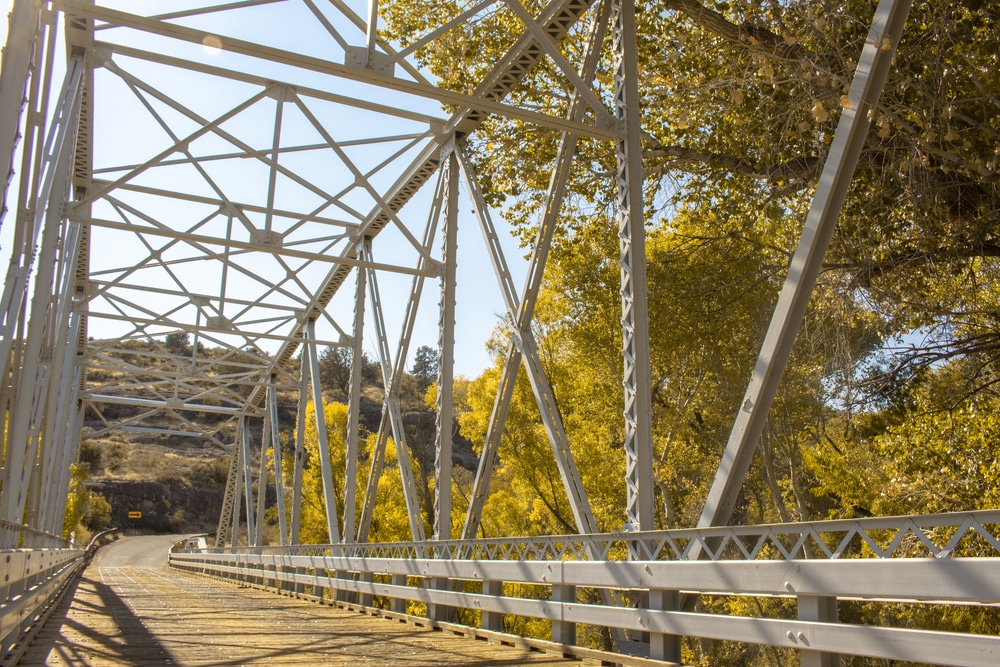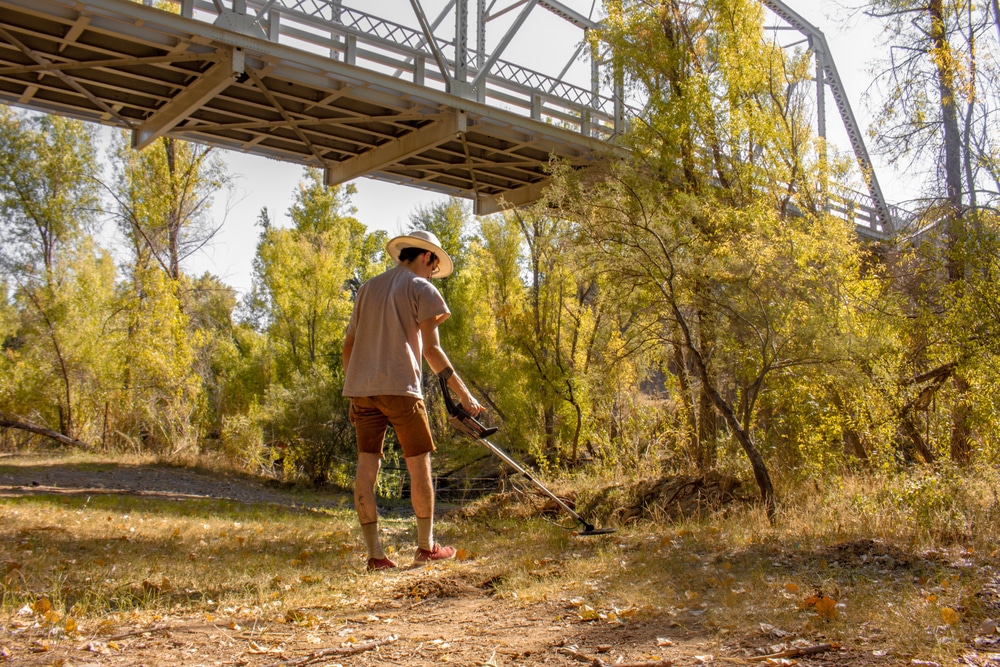The morning sun illuminates the stark beauty of Ajo’s landscape, casting long shadows across the open-pit mine that dominates the eastern edge of town. Unlike many of Arizona’s mining communities that flared briefly before fading into ghost towns, Ajo represents a different story—one of remarkable persistence through boom and bust cycles. Nestled in the Sonoran Desert of southwestern Arizona, approximately 43 miles from the Mexican border, this community still stands as a living testament to Arizona’s mining heritage, though much diminished from its heyday. The town’s Spanish name, meaning “garlic” (though some argue it derives from a Tohono O’odham word for paint), reflects the cultural crossroads where Anglo, Mexican, and Native American influences have converged for generations.

Walnut Grove has a storied past, once serving as a stagecoach stop and home to one of Arizona’s early reservoirs. While much of the town’s early infrastructure has faded, you can still explore its historical roots through old homesteads, cemetery sites, and stories of the infamous Walnut Grove Dam failure in 1890—a tragic event in Arizona history.
The nearby Hassayampa River Preserve offers hiking, birdwatching, and nature photography opportunities. Known for its rare, mostly underground flow, the river creates an oasis for cottonwoods, willows, and wildlife. Look for deer, javelina, and a variety of bird species.
The area around Walnut Grove is popular for rugged 4×4 and off-roading adventures. Roads like Walnut Grove Road offer scenic drives through desert landscapes, pine forests, and canyons. Be sure to check road conditions before you go, as many are unpaved and remote.

With minimal light pollution and wide-open skies, Walnut Grove is perfect for primitive camping and stargazing. Whether you’re pitching a tent near the river or parking an RV in a quiet spot, you’ll enjoy serene nights under a canopy of stars.

Within driving distance of Walnut Grove are several ghost towns and historic mining areas, such as Octave, Crown King, and Stanton. These towns offer relics of the gold rush era—abandoned buildings, mining shafts, and fascinating legends. Many can be accessed via off-road trails.

The contrast of lush riparian zones with high desert surroundings makes Walnut Grove a stunning place for photography. Sunrise and sunset bring golden hues to the landscape, and seasonal wildflowers add bursts of color in spring.

The remote setting and natural habitats attract a variety of desert and woodland birds. Watch for hawks, owls, quail, and migratory species, especially near water sources. Early morning and dusk are ideal times to spot wildlife in action.

The open spaces, cattle ranches, and dirt trails make Walnut Grove great for horseback riding. Some local ranches may offer guided rides or accommodations for equestrian travelers. Riding through this untouched terrain provides a true Old West experience.
Behind the statistics of production figures and casualty counts lie human stories that illuminate the lived experience of Walnut Grove. Cemetery markers, newspaper accounts, and surviving letters preserved by descendants give voice to individuals whose lives intersected with this frontier community.
James Albin Pattison (1831-1887) – Among the more substantial monuments in Walnut Grove Cemetery stands a granite obelisk commemorating Pattison, a mining engineer who supervised construction of the doomed dam but did not live to see its completion or failure. Born in Scotland and trained at the University of Edinburgh, Pattison represented the technical expertise that flowed into Western mining districts during their development. Letters preserved by his family describe his initial optimism about the dam project, tempered by growing concerns about design modifications made to reduce costs. In a particularly prophetic passage written in 1886, he noted that “the substitution of locally quarried stone for the specified Portland cement in the dam’s upper sections creates vulnerabilities that may prove troublesome during high water events.” Pattison died of pneumonia in December 1887, just months after the dam’s completion, and was buried with Masonic honors in the cemetery overlooking the community he helped develop.
María Guadalupe Soto (1860-1890) and Children – A weathered stone marker in the cemetery’s western section commemorates María and her three children—Antonio (age 6), Lucinda (age 4), and infant Joaquin—all killed when floodwaters destroyed their home near the river. Her husband Miguel, a worker at the nearby Crescent Mine, survived only because he was on night shift when the flood struck. Newspaper accounts describe Miguel’s desperate search for his family, finding their bodies nearly a mile downstream entangled in flood debris. The Arizona Miner reported that “the entire mining community, regardless of national origin, contributed generously to provide proper burial for the unfortunate family,” with the funeral attended by “nearly every soul remaining in the stricken settlement.” Miguel Soto remained in the area for several years, working various mining claims before eventually relocating to Globe, though according to church records, he returned annually to place flowers on his family’s grave until at least 1910.
Thomas J. McDonald (1835-1890) – As superintendent of the Walnut Grove Water Storage Company in charge of dam operations, McDonald became the disaster’s most controversial figure. His grave is not in Walnut Grove Cemetery; he is instead buried in his hometown of Cincinnati, Ohio, where his body was returned after recovery downstream from the dam site. McDonald had received multiple warnings about the dam’s condition during heavy rains preceding the collapse, including an urgent message from a worker reporting water seeping through the structure. According to testimony in subsequent investigations, McDonald decided against opening relief gates that might have reduced pressure, fearing damage to the expensive mechanism. His final communication, a telegram sent to company headquarters in New York the evening before the disaster, dismissively reported “excessive local concerns about minor seepage typical during first filling of any reservoir.” McDonald was among the first victims of the collapse, his quarters being located just below the dam. The subsequent investigation placed significant blame on his decisions, though company owners ultimately avoided major legal consequences.
Sarah Williams Foster (1845-1928) – Though not buried in Walnut Grove, Foster played a crucial role in documenting the community’s experience as schoolteacher from 1883 until the flood. Her detailed journal, preserved by the Sharlot Hall Museum in Prescott, provides invaluable insights into daily life before the disaster and immediate aftermath. Foster’s account of the flood night is particularly powerful: “Awakened by what sounded like continuous thunder, I reached my cabin door just as a wall of water carrying trees, buildings, and I fear many souls swept past on ground where yesterday children played. The darkness was complete but for occasional lightning, revealing scenes of such destruction as to suggest the apocalypse itself had arrived on the Hassayampa.” Foster organized a temporary school for surviving children in the weeks following the disaster, operating from a tent on higher ground while recovery efforts continued. Her persistence in maintaining educational normalcy despite catastrophe earned her the nickname “The Angel of Walnut Grove” in newspaper accounts.
Beyond these individual stories, cemetery records and newspaper reports reveal broader patterns of community life. Multiple grave markers belonging to members of the Sexton, Campbell, and Rodriguez families suggest the kinship networks that drew related individuals to the mining frontier. Several adjoining plots contain both Anglo and Hispanic surnames, indicating marriages that crossed ethnic boundaries despite the social divisions common in territorial Arizona. The clustering of death dates in certain periods documents the epidemic diseases that periodically swept through the crowded mining community, particularly the influenza outbreak of 1885-86 that claimed eleven lives over two winter months.

| Category | Details |
|---|---|
| Name | Walnut Grove, Arizona |
| Type | Ghost town |
| County | Yavapai County |
| Founded | 1864 (around the same time as early Arizona territorial settlements) |
| Status | Abandoned (ghost town) |
| Population (Current) | None (abandoned) |
| Historical Significance | Once a thriving farming and ranching area; site of the tragic Walnut Grove Dam failure in 1890 |
| Major Event | Walnut Grove Dam disaster – March 22, 1890. Dam collapse killed ~100+ people downstream |
| Economy (Past) | Agriculture, ranching, irrigation |
| Post Office | Operated from 1874 to 1913 |
| Decline Factors | Dam disaster, isolation, better opportunities elsewhere |
| Remnants Today | Scattered ruins, foundations, cemetery, and private ranches in the vicinity |
| Geographic Setting | Near the Hassayampa River, southwest of Prescott |
| Elevation | Approximately 3,400 feet (1,036 meters) |
| Access | Remote dirt roads; not well-developed for tourism |
| Nearby Features | Hassayampa River Preserve, remote high desert and riparian habitat |
| Best For | History enthusiasts, ghost town explorers, off-grid adventurers |
Walnut Grove’s story begins in the aftermath of the American Civil War, when prospectors fanned out across newly secured territories seeking mineral wealth. In 1864, explorers discovered promising gold deposits along the Hassayampa River in what was then part of Yavapai County. By 1866, a small mining camp had established itself at a spot where native walnut trees provided shade and building material, an oasis of green in an otherwise harsh landscape.
Unlike many Arizona mining camps that sprang up around single bonanzas, Walnut Grove developed more deliberately as a service center for numerous smaller mines scattered throughout the surrounding Weaver and Bradshaw Mountains. The settlement grew organically along the Hassayampa’s eastern bank, strategically positioned to support both placer mining operations working the riverbed gravels and harder-rock mining in the nearby hills.
By the mid-1870s, Walnut Grove had evolved from a rough camp into a more established community. Its economy diversified beyond direct mining activity to include ranching, small-scale agriculture, and commerce. The fertile bottomlands along the Hassayampa supported cattle operations and modest farms, while merchants established businesses catering to miners, ranchers, and travelers on the wagon road connecting Prescott to the southern Arizona settlements.
What distinguished Walnut Grove from dozens of similar mining communities was the ambitious infrastructure project that would ultimately seal its fate. In 1883, a group of investors led by New York capitalist Walnut Grove Water Storage Company began construction of a massive dam on the Hassayampa River about two miles upstream from the settlement. At 110 feet high and 400 feet long, the dam represented one of the most ambitious water control projects in territorial Arizona, designed to create a reservoir for both mining operations and agricultural irrigation.
The dam’s completion in 1887 marked Walnut Grove’s peak development. The settlement had grown to approximately 500 permanent residents, with several hundred more in the surrounding mining districts. The community boasted two general stores, three saloons, a school, a post office established in 1880, and an assay office. Unlike more infamous mining towns, Walnut Grove developed a reputation as a family-friendly settlement, with a significant population of women and children alongside the predominantly male mining workforce.
Modern visitors to the Walnut Grove site find themselves in a landscape reclaimed by nature yet still bearing unmistakable human imprints. The settlement’s footprint lies on private ranchland, with limited public access and no formal restoration or preservation efforts. What remains visible includes scattered stone foundations, root cellars cut into the hillsides, and occasional mining equipment too heavy or worthless to salvage.
The most substantial remaining structure is a partial stone wall from what was once the community schoolhouse, its weathered masonry standing defiantly against time and elements. Nearby, irrigation ditches—some predating the dam disaster—can still be traced across the landscape, testament to settlers’ persistent efforts to manage water in this semi-arid environment.
The most evocative remnants may be the least visible: artifacts embedded in the riverbank sediments downstream from the settlement. After heavy rains, the Hassayampa occasionally reveals fragments of the community’s material life—pieces of household crockery, metal tools, and personal possessions carried away by the catastrophic flood that transformed Walnut Grove from thriving community to historical footnote.
Approximately one mile northwest of the main settlement area, the Walnut Grove Cemetery occupies a gentle rise overlooking the Hassayampa’s course. This burial ground, better preserved than the settlement itself, provides the most tangible connection to the individuals who once called this place home. The infamous dam that failed so catastrophically left almost no visible remains, its massive stones having been salvaged for other construction or buried beneath accumulated sediment.
The Walnut Grove Cemetery, established around 1870, offers a poignant chronicle of frontier life and death. Enclosed by a simple barbed wire fence erected in the 1930s during a brief preservation effort, the rectangular plot measures approximately 200 by 150 feet. Desert vegetation—prickly pear cactus, mesquite, and occasional native walnut—has reclaimed much of the ground between graves, creating a scene of weathered dignity.
Approximately sixty marked graves populate the cemetery, though local historians believe additional unmarked burials exist beyond its fenced boundaries. The earliest legible dates are from 1871, while the latest extend to 1896, several years after the dam disaster that ultimately doomed the settlement. This continuation of burials after the 1890 flood reflects the community’s tenacious persistence despite catastrophic setback.
The cemetery’s markers tell stories of the diverse population that comprised Walnut Grove. Simple wooden crosses, now weathered to near-illegibility, stand alongside more substantial stone monuments bearing names that reflect the international character of Western mining communities—English, Irish, German, Mexican, and Chinese among them. Several markers bear the distinctive symbolism of fraternal organizations, particularly the Masonic square and compass, indicating the social structures that helped bind this frontier community.
What makes the Walnut Grove Cemetery particularly significant is its documentation of the community’s defining tragedy. A row of markers bearing death dates of February 22, 1890, silently commemorates victims of the dam collapse that sent a 40-foot wall of water through the settlement in the pre-dawn hours. Not all flood victims are buried here; many bodies were never recovered from the debris-choked riverbed that carried them downstream, while others were returned to distant hometowns for burial.
The cemetery’s placement on higher ground spared it from the floodwaters that devastated the settlement, preserving this memorial landscape while much of the community it served was swept away. Today, the cemetery stands as the most intact physical reminder of Walnut Grove’s existence, its weathered stones bearing silent witness to both ordinary frontier hardships and extraordinary disaster.
Unlike larger settlements that developed separate burial grounds for different social classes or ethnic groups, Walnut Grove maintained a single cemetery that served its diverse population. This pattern reflects both the community’s relatively modest size and the pragmatic approach to death necessitated by frontier conditions.
The cemetery’s layout reveals both organization and adaptation. Graves generally align east-west following Christian burial traditions, but family groupings sometimes interrupt this pattern to keep relatives together. No formal sections divided ethnic or religious groups, though mapping of identifiable graves suggests some informal clustering occurred, with Hispanic families predominantly in the cemetery’s western portion and Anglo miners concentrated in the northeast corner.
Burial practices visible at Walnut Grove Cemetery balanced frontier necessity with cultural traditions. The desert environment and limited resources dictated simpler ceremonies than might have occurred in more established communities, while the isolation from larger religious institutions meant local adaptations of funeral customs. Contemporary accounts describe community-wide participation in burials, with miners often contributing funds to provide decent interment for colleagues regardless of their origin or status.
The cemetery’s markers reflect the socioeconomic diversity of Walnut Grove. Several substantial monuments, typically of granite or marble, mark the graves of mine owners, merchants, and their families. These more elaborate markers were often shipped from Prescott or even San Francisco, representing significant expense and logistical challenge. In contrast, most miners and laborers rest beneath simpler local stone markers or wooden crosses, many now deteriorated beyond identification.
Perhaps most poignant are the numerous children’s graves, their small dimensions testifying to the harsh realities of frontier childhood. Infant and child mortality ran exceptionally high in isolated communities like Walnut Grove, where medical care was limited and diseases spread quickly through crowded mining households. Several family plots contain multiple child burials, silently documenting the repeated grief endured by pioneer parents.
The cemetery continued receiving burials even after the 1890 dam disaster, though at a dramatically reduced rate as the community gradually dispersed. The final documented interment occurred in 1896, when Mary Sorenson, widow of a miner killed in the flood, was laid to rest beside a memorial marker for her never-recovered husband. After this point, remaining residents typically buried their dead in Prescott or other more established communities.
Walnut Grove itself never supported a dedicated newspaper, instead relying on publications from nearby communities for news coverage and communication. The primary newspapers serving the settlement were the Arizona Miner (later renamed the Arizona Journal-Miner) from Prescott and, after its establishment in 1882, the Yavapai Shaft from nearby Wickenburg.
These regional publications provided essential connections between isolated mining communities and the broader territory. The Arizona Miner typically included a weekly column titled “From the Hassayampa” that reported on developments in Walnut Grove and other settlements along the river. These reports, submitted by local correspondents, covered mining news, business developments, social events, and crime—creating a valuable chronicle of community evolution.
While no dedicated newspaper office existed in Walnut Grove itself, several residents served as regular correspondents for regional publications. Most notable among these was Edward G. Peck, a store owner who submitted weekly reports to the Arizona Miner from 1877 until the flood in 1890. Peck’s detailed accounts of local happenings, preserved in newspaper archives, provide the most comprehensive contemporary record of daily life in Walnut Grove.
The construction of the Walnut Grove Dam generated significant newspaper coverage throughout Arizona Territory. Initial reports emphasized the project’s ambition and potential economic benefits, with the Arizona Miner declaring it would “transform the Hassayampa region into the most prosperous mining district in the Southwest.” As construction progressed, newspapers documented both technical challenges and labor disputes, including an 1885 strike by Chinese workers protesting dangerous conditions.
When catastrophe struck in February 1890, newspaper coverage provided the primary documentation of both immediate impact and aftermath. The Arizona Journal-Miner dispatched a special correspondent who reached Walnut Grove two days after the flood, producing a detailed account of destruction and recovery efforts. This reporting, while sometimes sensationalized, created a valuable historical record of the disaster, including lists of identified victims and descriptions of rescue attempts.
In the flood’s aftermath, newspaper coverage shifted to questions of responsibility and compensation. The Yavapai Shaft took a particularly aggressive stance, publishing a series of investigative articles alleging negligence by the dam’s owners and operators. These reports helped shape both public opinion and subsequent legal proceedings, with several excerpts entered as evidence in lawsuits filed by survivors and victims’ families.
Unlike more fortunate mining communities that benefited from direct railroad access, Walnut Grove remained reliant on wagon transportation throughout its existence. This isolation significantly impacted the settlement’s development, limiting both the scale of mining operations and the community’s economic diversification.
The nearest railroad connection was the Prescott & Arizona Central Railway, which reached Prescott in 1886 but never extended southward to the Hassayampa communities. This placed Walnut Grove at a significant disadvantage compared to mining districts served directly by rail, as ore had to be transported by wagon to Prescott at considerable expense before reaching modern transportation networks.
The primary transportation artery serving Walnut Grove was the Prescott-Wickenburg wagon road, which followed the Hassayampa River valley and connected the settlement to commercial centers in both directions. This unpaved route, subject to washouts during seasonal flooding, could become nearly impassable during wet periods, further isolating the community. Freight wagons typically required two full days to travel between Walnut Grove and Prescott, a distance of only fifteen miles as the crow flies but considerably longer along the winding river route.
Limited transportation infrastructure directly impacted mining operations around Walnut Grove. Only high-grade ore could justify the expense of wagon transport to distant smelters, meaning lower-grade deposits remained uneconomical despite their mineral content. This transportation bottleneck was one factor driving construction of the ill-fated dam, as project supporters argued that increased water availability would allow for on-site processing of lower-grade ores.
Passengers traveling to and from Walnut Grove relied primarily on stagecoaches that operated irregular service along the Prescott-Wickenburg route. These coaches, operated by various small companies rather than major stage lines, offered basic transportation but little comfort on the rough journey. According to contemporary accounts, the trip from Prescott to Walnut Grove typically cost $2.50 and required 6-8 hours depending on road conditions.
The lack of railroad connectivity ultimately contributed to Walnut Grove’s vulnerability to disaster. When the dam collapsed in February 1890, the isolated community had no rapid means of summoning assistance or evacuating survivors. The first outside help arrived nearly 24 hours after the flood, having traveled by horseback from Prescott after a survivor managed to reach a telegraph station with news of the catastrophe.
In a cruel irony, plans for extending railroad service to the Hassayampa mining districts were under active discussion when disaster struck. The Arizona Miner had reported in January 1890 that surveys were underway for a potential spur line from Prescott to Walnut Grove, a development that might have transformed the settlement’s economic prospects had it not been overtaken by tragedy just weeks later.
The catastrophic dam failure of February 22, 1890, marks the definitive turning point in Walnut Grove’s history, transforming a growing settlement into a community living on borrowed time. The disaster’s statistics remain sobering even by modern standards: at least 70 confirmed deaths (though some estimates range as high as 100 when accounting for undocumented workers), destruction of 25 substantial buildings, and obliteration of all infrastructure along the riverbed including bridges, irrigation systems, and processing facilities.
The flood’s timing—striking at approximately 2:00 a.m. when most residents were asleep—contributed to its deadly impact. Many victims had no warning before their homes were swept away by the 40-foot wall of water. Survivors described awakening to a “roar like continuous thunder” as the floodwaters charged down the narrow canyon, carrying debris that became deadly projectiles in the torrent. Those who managed to reach higher ground could only watch helplessly as neighbors and family members were carried away in the darkness.
Initial response to the disaster came primarily from within the community itself, as Walnut Grove’s isolation delayed outside assistance. Survivors organized search parties at first light, recovering bodies and providing basic aid to the injured. The first outside help arrived late on February 23rd when riders from Prescott reached the devastated settlement with medical supplies and emergency rations.
In the disaster’s immediate aftermath, the community showed remarkable resilience. Temporary shelters were established on higher ground, while salvage operations recovered what could be saved from buildings not completely destroyed. The Arizona Miner reported that mining operations in the surrounding hills resumed within two weeks of the flood, providing crucial employment for survivors who had lost everything.
This initial determination to rebuild proved unsustainable, however, as the full implications of the disaster became clear. The destruction of water management infrastructure meant that both mining operations and agriculture faced significant new obstacles. The dam company quickly declared bankruptcy, avoiding most liability claims while eliminating any possibility of reconstruction. Without the promised water resource that had driven recent development, Walnut Grove’s economic rationale diminished significantly.
The community’s decline followed a gradual rather than immediate trajectory. Some residents relocated immediately after the disaster, particularly those who had lost family members or their entire property. Others remained, attempting to rebuild lives and livelihoods along the altered riverbed. Census records indicate that by 1895, Walnut Grove’s population had declined to approximately 150 permanent residents, less than a third of its pre-disaster peak.
Several factors accelerated this decline beyond the immediate flood damage. Insurance coverage was virtually non-existent for most residents, meaning that reconstruction required personal resources many survivors lacked. Legal claims against the dam’s owners dragged through courts for years with minimal compensation ultimately provided. Perhaps most significantly, the psychological impact of the disaster cast a shadow over the community that never fully dissipated, with survivors reporting recurring nightmares and anxiety during rainstorms.
By 1900, Walnut Grove had effectively ceased to exist as a functional community, though scattered ranches and small mining operations continued in the vicinity. The post office officially closed in 1901, requiring remaining residents to travel to Wagoner or Kirkland for mail service. Buildings that had survived the flood were gradually dismantled for materials or abandoned to the elements. By the 1920s, only the cemetery and a few stone foundations remained as evidence of the settlement that once thrived along the Hassayampa.
Walnut Grove occupies a distinctive place in Arizona’s mining history, significant not only for its tragic end but for what it reveals about water management, technology, and risk in developing the arid Southwest. Unlike mining disasters stemming from underground accidents or violence, Walnut Grove’s destruction resulted from infrastructure failure, making it an important case study in the environmental history of resource extraction.
The Walnut Grove Dam represented one of the earliest large-scale attempts at water control in Arizona Territory, predating more famous projects like Roosevelt Dam by nearly two decades. Its construction reflected the growing influence of Eastern capital in Western resource development, with New York investors funding a project designed to extract maximum value from both mineral deposits and limited water resources. The dam’s catastrophic failure highlighted the dangers of applying engineering approaches developed for Eastern watersheds to the drastically different hydrological conditions of the Southwest.
From an archaeological perspective, Walnut Grove presents unique research opportunities precisely because of its dramatic abandonment. Unlike communities that declined gradually with extensive salvage of materials, the flood created something approaching a “snapshot” of 1890s material culture. Limited archaeological investigations conducted in the 1970s recovered numerous artifacts from flood deposits downstream, creating collections that document daily life in remarkable detail. These materials, currently housed at the Sharlot Hall Museum in Prescott, include everything from industrial equipment to personal items like clothing fasteners, toys, and household ceramics.
The disaster’s legal aftermath established important precedents in Arizona water law and corporate liability. Lawsuits filed by survivors and victims’ families advanced new legal theories regarding corporate responsibility for infrastructure safety, though most ultimately failed against the company’s bankruptcy protections. The territorial legislature responded to public outrage by enacting Arizona’s first dam safety regulations in 1892, requiring engineering review and inspection protocols that remain foundational to modern water management practices.
For the Yavapai people, whose ancestral territories encompass the Hassayampa watershed, Walnut Grove represents one chapter in a longer story of environmental transformation. Ethnographic records suggest the area had seasonal significance for gathering walnut, mesquite, and other plant resources, activities disrupted by mining development. Some Yavapai individuals found employment in the mining district, creating economic connections while experiencing the displacement typical of indigenous peoples throughout the mining West.
The Walnut Grove Cemetery, as the settlement’s most intact remaining feature, holds particular cultural significance for descendants of community members and Arizona pioneer families more broadly. The burial ground represents not just individual lives but the collective experience of risk, opportunity, and occasional disaster that characterized frontier development. Its continued existence, despite the community’s disappearance, stands as a powerful reminder of the human costs associated with resource extraction and technological optimism on the mining frontier.
The persistence of Walnut Grove Cemetery through more than a century of abandonment represents both remarkable survival and ongoing conservation challenges. Unlike cemeteries in communities that evolved into modern settlements, Walnut Grove’s burial ground has lacked institutional caretakers for most of its existence, relying instead on sporadic attention from descendants, historical organizations, and concerned individuals.
Early conservation efforts were primarily the work of survivors and their families. According to accounts collected by the Yavapai County Historical Society, former residents organized occasional maintenance visits into the early 1900s, clearing vegetation and repairing damaged markers. One particularly dedicated individual, James Campbell (whose parents and younger brother died in the flood), reportedly traveled annually from his Phoenix home to maintain family graves until his death in 1932.
More organized preservation began in the 1930s when members of the Civilian Conservation Corps constructed the simple barbed wire fence that still defines the cemetery’s boundaries. This Depression-era project, while utilitarian in approach, provided crucial protection from cattle that had begun grazing the surrounding ranchland, preventing further damage to grave markers from livestock.
The most significant conservation initiative came in 1976 when the Arizona Pioneer Cemetery Research Project documented all visible graves, creating a photographic record and transcriptions of legible inscriptions. This documentation has proven invaluable as natural weathering continues to degrade markers, with some inscriptions now completely lost except in these archival records. The project’s mapping established the cemetery’s dimensions and internal organization, information that guides current preservation efforts.
Contemporary conservation faces significant challenges beyond normal weathering and vegetation management. The cemetery’s remote location has made it vulnerable to occasional vandalism, with several markers damaged or displaced by trespassers despite its private property status. Flash flooding, while less devastating than the 1890 disaster, periodically affects the site, with a particularly severe event in 2004 toppling several monuments on the cemetery’s eastern edge.
Current maintenance relies on cooperation between several stakeholders. The private landowner who controls access to the site permits periodic maintenance visits by historical organizations and descendants. The Yavapai Cemetery Association coordinates two annual cleanup events that remove invasive vegetation and debris while documenting any new damage to markers. These events typically occur in April and October when weather conditions are favorable for outdoor work in this elevation.
Memorial practices associated with Walnut Grove have evolved as direct connections to the community have diminished. While early remembrances focused on personal grief and maintenance of specific family plots, contemporary memorialization takes more collective forms. The most significant recurring event is a ceremony held each February 22nd (the flood anniversary) when representatives from various historical organizations place wreaths at the cemetery and read aloud the names of known flood victims.
The Walnut Grove Dam disaster retains a place in regional historical consciousness disproportionate to the settlement’s size or lifespan. Annual newspaper features in Arizona publications often coincide with the February anniversary, while local historical societies maintain exhibits related to the catastrophe. This continued remembrance stands in stark contrast to many similar mining communities that have faded completely from public knowledge, suggesting the disaster narrative provides a compelling hook that preserves Walnut Grove’s place in regional memory.
For those wishing to experience Walnut Grove firsthand, ethical visitation practices are essential to preserving this fragile historical resource and respecting its significance to descendants. The cemetery and settlement site lie on private property, with no public access established for casual visitors. Serious researchers and descendants can arrange limited visits through the Yavapai Cemetery Association, which maintains working relationships with landowners and coordinates approved access.
Those granted permission to visit will find the site accessible only by unpaved roads requiring high-clearance vehicles, with the final approach necessitating a hike of approximately half a mile across uneven terrain. Visitors should come prepared with appropriate footwear, water, and sun protection, particularly during summer months when temperatures regularly exceed 100°F. Rattlesnakes and other desert wildlife are common in the area, requiring awareness and caution.
The most significant preservation challenges facing Walnut Grove come not from intentional vandalism but from well-meaning visitors unfamiliar with archaeological and conservation best practices. Those permitted to visit should observe fundamental principles: take only photographs and leave only footprints, avoid moving or “cleaning” grave markers, and refrain from collecting any artifacts regardless of how insignificant they may appear. Even small items like square nails or pottery fragments hold research value in their original context that is lost once removed.
For those interested in Walnut Grove’s history without visiting the remote site itself, several institutional resources provide accessible alternatives. The Sharlot Hall Museum in Prescott maintains the most comprehensive collection of photographs, artifacts, and documents related to the settlement and disaster. Their permanent exhibition “Riches, Ruin, and Recovery: The Impact of Mining in Yavapai County” includes a detailed section on Walnut Grove with original objects recovered from flood deposits.
Digital resources have expanded access to Walnut Grove’s story for researchers and descendants. The Arizona Memory Project (azmemory.azlibrary.gov) includes digitized newspaper coverage of the dam disaster and its aftermath, while the Arizona Pioneer Cemetery Research Project database provides searchable information on documented burials. These resources allow meaningful connection with Walnut Grove’s history while reducing impact on the fragile physical site.
As shadows lengthen across Walnut Grove Cemetery, the weathered stones stand as silent witnesses to both ordinary frontier struggles and extraordinary catastrophe. This isolated burial ground, outlasting the community it once served, embodies the complex legacy of Arizona’s mining frontier—the ambition, technical innovation, cultural exchange, and occasional disaster that characterized Anglo settlement of the territorial Southwest.
The ill-fated dam that transformed Walnut Grove from growing community to historical footnote represents more than just an engineering failure. It exemplifies the broader pattern of attempting to overcome environmental limitations through technology, a recurring theme in Western development. The project’s backers envisioned controlling the Hassayampa’s unpredictable flows to enable expanded resource extraction, only to discover the desert’s hydrological realities could not be so easily mastered. When the dam failed in those early morning hours of February 1890, it demonstrated the limits of technical expertise and the consequences of prioritizing economic potential over safety margins.
Yet Walnut Grove was more than just the site of disaster. Before floodwaters rewrote its story, the settlement represented the diverse social tapestry typical of Western mining communities. Anglo, Hispanic, Chinese, and indigenous residents created an imperfect but functional community despite significant social divisions. The cemetery’s markers, bearing names reflecting multiple national origins, document this diversity while their placement reveals both integration and segregation in death as in life.
The community’s brief existence intersected with broader patterns in Arizona’s development—the flow of Eastern capital into Western resources, the transition from individual prospecting to corporate mining, and the crucial role of water management in arid lands development. These themes would play out repeatedly across the Southwest, though rarely with such dramatic conclusion.
Today, as Walnut Grove fades further into historical memory, the weathered cemetery and scattered foundations speak to the impermanence of human endeavors against the vast backdrop of the Sonoran Desert. Flash floods still periodically scour the Hassayampa’s banks, occasionally revealing artifacts that connect present visitors to lives abruptly interrupted by disaster. The walnut trees that gave the settlement its name continue their cycles of growth and renewal, indifferent to the human drama that briefly centered on this river bend.
Yet something endures beyond physical remains—the stories of individuals who sought opportunity in this harsh landscape, building lives and community before disaster struck. Their collective experience, preserved in cemetery markers, newspaper accounts, and archaeological remains, offers valuable perspectives on risk, resilience, and the complex relationship between technological optimism and environmental reality that continues to shape development throughout the arid Southwest.